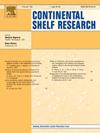Declining bivalve species and functional diversity along a coastal eutrophication-deoxygenation gradient in the northern Gulf of Mexico
IF 2.1
3区 地球科学
Q2 OCEANOGRAPHY
引用次数: 0
Abstract
Coastal eutrophication and hypoxia are growing challenges globally, yet their impacts can be difficult to evaluate because of limited biomonitoring that typically postdates the onset of these stressors. We address this limitation by investigating how the taxonomic and functional diversity of marine bivalve communities vary with primary productivity, dissolved oxygen, temperature, and seafloor sediment properties across the northern Gulf of Mexico, a region that includes one of the world's largest dead zones. We hypothesized that taxonomic and functional richness would decline in eutrophic and hypoxic coastal environments. Live bivalve mollusks were sampled at 15 stations, spanning more than 600 km of continental shelf habitat. Individuals were identified to species and characterized based on feeding, mobility, fixation, life position relative to the sediment-water interface, and body size. Alpha and beta taxonomic and functional diversity were computed using Hill numbers and linear models used to assess their covariation with regional environmental conditions. Taxonomic and functional diversity were highest in less eutrophic environments characterized by normoxic conditions, and lowest in more eutrophic environments where oxygen was more limited. Community-level differences were underlain by functional shifts, with abundant shallow-infaunal, deposit and mixed feeders in more eutrophic settings, in contrast with less eutrophic settings where suspension feeders were more abundant. Median body size increased with eutrophication, possibly as a result of hypoxia-induced declines in predator and competitor populations. These results suggest that intensifying nutrient loading and deoxygenation in the coastal zone will cause declines in multiple dimensions of benthic biodiversity with implications for ecosystem function.
墨西哥湾北部沿岸富营养化-脱氧梯度双壳类动物物种和功能多样性的减少
沿海富营养化和缺氧是全球面临的日益严峻的挑战,但由于生物监测有限,通常在这些压力发生之后才进行,因此很难评估它们的影响。为了解决这一局限性,我们研究了墨西哥湾北部海洋双壳类群落的分类和功能多样性如何随初级生产力、溶解氧、温度和海底沉积物特性的变化而变化。我们假设,在富营养化和缺氧的沿海环境中,分类和功能的丰富性会下降。我们在 15 个站点采集了活体双壳类软体动物样本,横跨 600 多公里的大陆架栖息地。根据摄食、移动、固定、相对于沉积物-水界面的生活位置和体型,对个体进行了物种鉴定和特征描述。利用希尔数计算α和β分类和功能多样性,并利用线性模型评估它们与区域环境条件的协变关系。在以常氧条件为特征的富营养化程度较低的环境中,分类和功能多样性最高,而在氧气较为有限的富营养化程度较高的环境中,分类和功能多样性最低。群落水平差异的基础是功能转变,在富营养化程度较高的环境中,浅海动物、沉积物和混合摄食动物较多,而在富营养化程度较低的环境中,悬浮摄食动物较多。中位体型随着富营养化的加剧而增大,这可能是缺氧导致捕食者和竞争者数量减少的结果。这些结果表明,沿岸带营养负荷和脱氧的加剧将导致底栖生物多样性的多方面下降,并对生态系统的功能产生影响。
本文章由计算机程序翻译,如有差异,请以英文原文为准。
求助全文
约1分钟内获得全文
求助全文
来源期刊

Continental Shelf Research
地学-海洋学
CiteScore
4.30
自引率
4.30%
发文量
136
审稿时长
6.1 months
期刊介绍:
Continental Shelf Research publishes articles dealing with the biological, chemical, geological and physical oceanography of the shallow marine environment, from coastal and estuarine waters out to the shelf break. The continental shelf is a critical environment within the land-ocean continuum, and many processes, functions and problems in the continental shelf are driven by terrestrial inputs transported through the rivers and estuaries to the coastal and continental shelf areas. Manuscripts that deal with these topics must make a clear link to the continental shelf. Examples of research areas include:
Physical sedimentology and geomorphology
Geochemistry of the coastal ocean (inorganic and organic)
Marine environment and anthropogenic effects
Interaction of physical dynamics with natural and manmade shoreline features
Benthic, phytoplankton and zooplankton ecology
Coastal water and sediment quality, and ecosystem health
Benthic-pelagic coupling (physical and biogeochemical)
Interactions between physical dynamics (waves, currents, mixing, etc.) and biogeochemical cycles
Estuarine, coastal and shelf sea modelling and process studies.
 求助内容:
求助内容: 应助结果提醒方式:
应助结果提醒方式:


